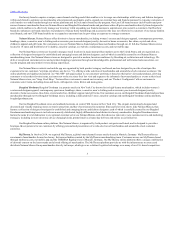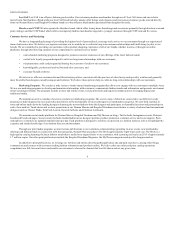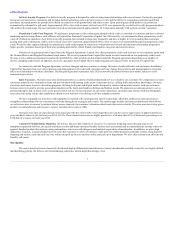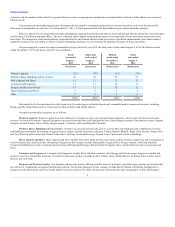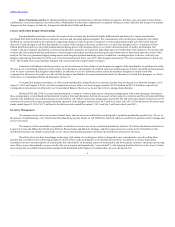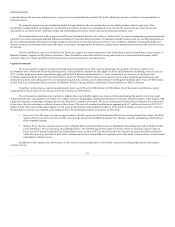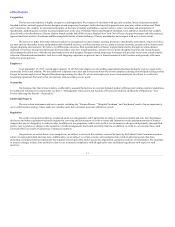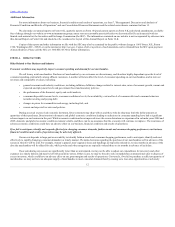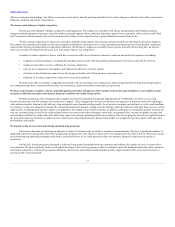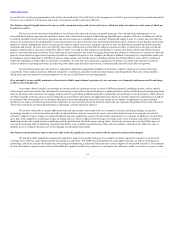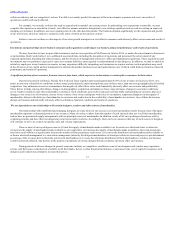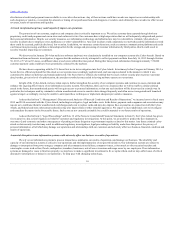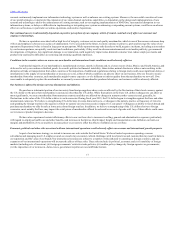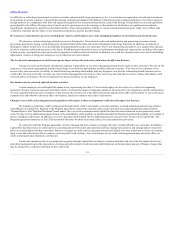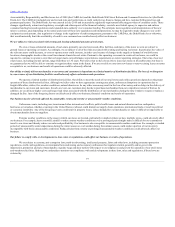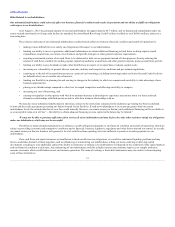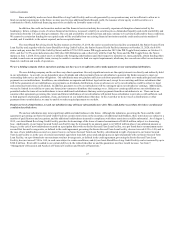Neiman Marcus 2014 Annual Report Download - page 16
Download and view the complete annual report
Please find page 16 of the 2014 Neiman Marcus annual report below. You can navigate through the pages in the report by either clicking on the pages listed below, or by using the keyword search tool below to find specific information within the annual report.
Table of Contents
within our industry and our competitors’ actions. If we fail to accurately predict the amounts of these investments, expenses and costs, our results of
operations could be adversely affected.
For example, we routinely evaluate the need to expand and/or remodel our existing stores. In undertaking store expansions or remodels, we must
complete the expansion or remodel in a timely, cost‑effective manner, minimize disruptions to our existing operations and succeed in creating an improved
shopping environment. In addition, new store openings involve the risks described under “Our business depends significantly on the expansion and growth
of our retail stores, which are subject to numerous risks, some of which are beyond our control.”
Failure to execute on these or other aspects of our store growth strategies in a cost‑effective manner could adversely affect our revenues and results of
operations.
Investments and partnerships in new business strategies and acquisitions could impact our business, financial performance and results of operations.
We may, from time to time, acquire other businesses, such as our acquisition of MyTheresa in October 2014, or make other investments in businesses
or partnerships, which would subject us to additional associated risks, including the integration of operations and personnel, the achievement of any
expected operational, branding and other synergies, and the diversion of management resources to effect and implement acquisitions. These acquisitions and
investments may not perform as expected or cause us to assume liabilities unrecognized or underestimated in due diligence. In addition, we may be unable to
retain key employees in any business we acquire, we may experience difficulty integrating any businesses we acquire, and any such acquisitions may result
in the diversion of our capital and our management’s attention from other business issues and opportunities, any of which could harm our business, financial
performance and results of operations.
A significant portion of our revenue is from our stores in four states, which exposes us to downturns or catastrophic occurrences in those states.
Our stores located in California, Florida, New York and Texas together represented approximately 50% of our revenues in fiscal year 2015. As a
result, we are more vulnerable to conditions in those states, particularly the major metropolitan areas in those states, than our more geographically diversified
competitors. Any unforeseen events or circumstances that negatively affect those states could materially adversely affect our revenues and profitability.
These factors include, among other things, changes in demographics, population and employee bases, wage increases, changes in economic conditions,
severe weather conditions and other catastrophic occurrences. Such conditions may result in reduced customer traffic and spending in our stores, physical
damage to our stores, loss of inventory, closure of one or more of our stores, inadequate work force in our markets, temporary disruption in the supply of
merchandise, delays in the delivery of merchandise to our stores and a reduction in the availability of merchandise in our stores. Any of these factors may
disrupt our business and materially adversely affect our business, financial condition and results of operations.
We are dependent on our relationships with certain designers, vendors and other sources of merchandise.
Our relationships with established and emerging designers are a key factor in our success as a luxury merchandise retailer because sales of designer
merchandise represent a substantial portion of our revenues. Many of our key vendors limit the number of retail channels they use to sell their merchandise,
and we have no guaranteed supply arrangements with our principal sources of merchandise. In addition, nearly all of our top designer brands are sold by
competing retailers and have their own proprietary retail stores and/or websites. Accordingly, there can be no assurance that any of such sources or designers
will continue to sell to us or meet our quality, style and volume requirements.
If one or more of our top designers were to (i) limit the supply of merchandise made available to us for resale on a wholesale basis or otherwise,
(ii) increase the supply of merchandise made available to our competitors, (iii) increase the supply of merchandise made available to their own proprietary
retail stores and websites or significantly increase the number of their proprietary retail stores, (iv) convert the distribution of merchandise made available to
us from a wholesale arrangement to a concession arrangement (whereby the designer merchandises its boutique within our store and pays us a pre-determined
percentage of the revenues derived from the sale of such merchandise) or (v) cease the wholesale distribution of their merchandise to retailers, our business
could be adversely affected. Any decline in the quality or popularity of our top designer brands could also adversely affect our business.
During periods of adverse changes in general economic, industry or competitive conditions, some of our designers and vendors may experience
serious cash flow issues, reductions in available credit from banks, factors or other financial institutions, or increases in the cost of capital. In response, such
designers and vendors may attempt to increase their prices,
15


